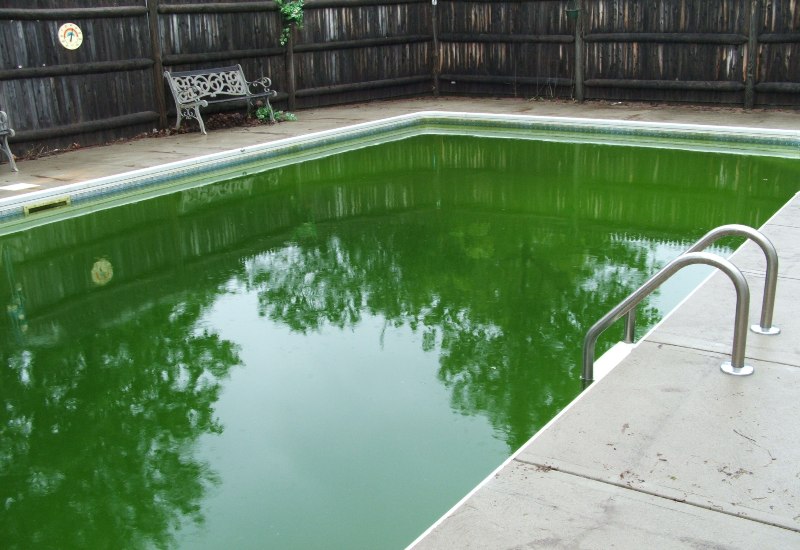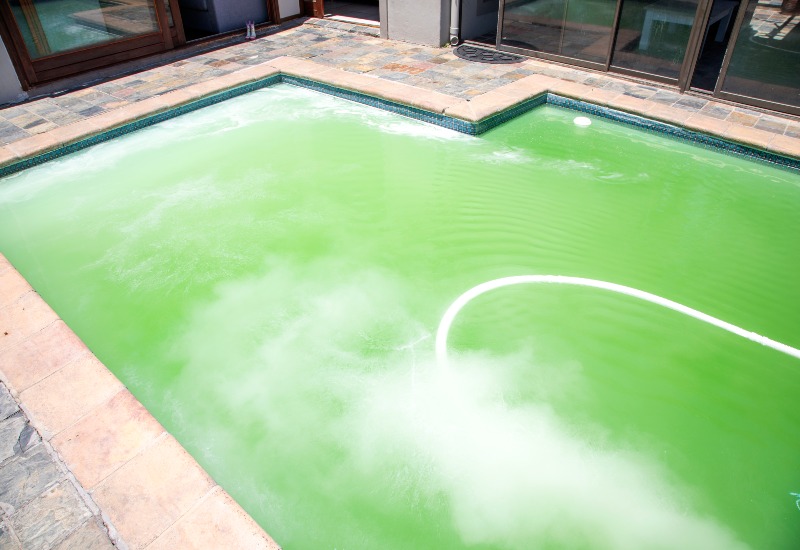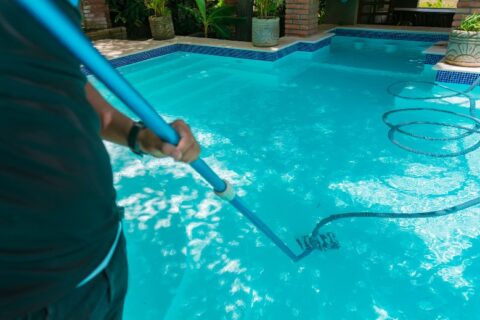Why is My Pool Water Green?
Understanding Green Pool Water
If you’ve ever looked outside and thought “Oh no, my swimming pool is green,” we may be able to help. Discovering that your once-clear swimming pool has turned an unappealing shade of green can be disheartening. This transformation often leaves many pool owners puzzled. Understanding the root causes of this change and how to address it can help restore your pool’s water to its pristine condition, ensuring safe and enjoyable swimming.
Why is My Swimming Pool Green?
The primary reason for the green tint in pool water is the presence of swimming pool green algae. Algae are microscopic plants that thrive in water environments, and their rapid growth can quickly impart a green hue to your pool. Factors such as sunlight, warm temperatures, and nutrients in the water can accelerate algae development, adding a green tint to what was once clear water.

Is Green Pool Water Safe for Swimming?
The question, “Can you swim in a green pool,” is common among pool owners facing this issue. The straightforward answer is no. Swimming in green water is not advisable as it can host various pathogens, including bacteria that may cause infections. Additionally, the presence of algae makes the pool slippery and can obscure visibility, which might lead to unsafe swimming conditions.
Factors Contributing to Algae Growth
Understanding the factors that contribute to algae growth in swimming pools is crucial for maintaining clear and healthy water. Here’s a closer look at the main contributors:
Inadequate Filtration: The filtration system plays a pivotal role in keeping pool water clean. If the pool’s filter does not run for an adequate amount of time each day, it may fail to capture and remove algae spores and other microscopic contaminants. This can result in the accumulation of algae, making the water appear green. Ensuring that the filtration system is properly sized for your pool and operates sufficiently each day is essential for maintaining water clarity.
Improper Chemical Balance: Maintaining the correct chemical balance in your pool is critical to prevent algae growth. Incorrect pH and alkalinity levels can compromise the effectiveness of sanitizers like chlorine, allowing algae to thrive unchecked. Additionally, inadequate sanitizer levels fail to kill algae and bacteria, leading to further growth. Regular testing and adjustment of your pool’s water chemistry are necessary to create an environment that is hostile to algae.
Environmental Factors: Algae can also flourish due to external environmental factors. Excess nutrients, which algae feed on, can enter your pool from various sources such as lawn fertilizers, decaying leaves, and other organic debris. Stormwater runoff is another common culprit, carrying phosphates and other algae-promoting nutrients into the pool. Keeping your pool area clean and managing runoff and debris can significantly reduce nutrient levels in the water.
By understanding and managing these factors, pool owners can effectively prevent the recurrence of green water, ensuring their swimming environment remains clean, healthy, and inviting. Regular maintenance and proactive water management are key to combating algae growth and maintaining an enjoyable pool.
Common Misconceptions About Green Pool Water and Avoidable Mistakes
When dealing with a green swimming pool, many owners fall prey to misconceptions such as believing that extra chlorine can instantly fix the issue, or that simply filtering the water is enough to clear out algae. These misunderstandings can lead to ineffective treatments and further complications. It’s essential to approach the treatment properly rather than relying on quick fixes.
How to Clean a Green Swimming Pool
If you’re pondering “How do I fix a green swimming pool,” follow these systematic steps to restore your pool’s water clarity:
Test and Balance Water Chemistry: Check the pH and alkalinity levels and adjust them if necessary to create an environment that’s less hospitable to algae.
Shock the Pool: Use a chlorine shock treatment to kill existing algae. This might require a larger amount of chlorine than used in regular maintenance.
Brush the Pool: Manually brush the walls and floor of the pool to break up the algae’s hold on surfaces.
Run the Filter: After shocking and brushing the pool, run the filter continuously for at least 24-48 hours to remove the dead algae.
Vacuum the Pool: Once the algae have settled, vacuum the pool to remove the dead algae debris.
Re-test the Water: After cleaning, test the water again to ensure all chemical levels are safe for swimming.
This green swimming pool water treatment is effective but can be labor-intensive and requires precise chemical handling.

Need Pool Service in Virginia, Washington DC, or Maryland?
Dealing with a green pool can be challenging, but at Millennium Pools & Spas, we have the expertise to clear up your water quickly. Since 2006, our family-owned business has served Virginia, Washington DC, and Maryland, offering a full range of services from routine service and maintenance to comprehensive repairs. If you’re struggling with a green pool and wondering what to do, don’t hesitate to reach out. Contact us today online or at (703) 939-5062 to schedule a consultation with our experienced team, committed to quality service and customer satisfaction. Let Millennium Pools & Spas help you enjoy a clean and inviting pool again!

